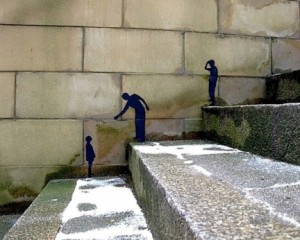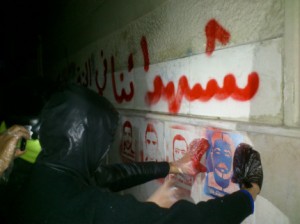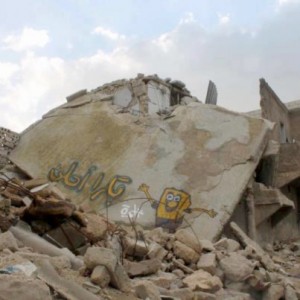
Freedom Graffiti in Russia and Syria: The Artistry of Indestructibility by Diana Bruk

A staircase guides you on how to treat others. Photo courtesy of Tarek Alghorani. https://www.facebook.com/MAD.GRAFFiTi.Week.SYRiaa?fref=ts
In a very poor city in Russia, where the buildings were crumbling, where middle-aged men were urinating on the bare skeletons of burnt-out cars, where children were playing with pebbles in the puddles of unpaved roads, there was once a peeling wall on which someone had scribbled, in coal, the words, “I can’t take this anymore.” I remember looking at this and thinking that it was actually strikingly artistic, the way the artist had chosen to use a medium that is an internationally recognized symbol for poverty, the way the canvas itself expressed its point, the way it drew attention to this forgotten structure, and the way that, simple and yet irremovable from its context, it could so succinctly express the emotions of its own community.
In my wanderings around Russia, I frequently came across more of these these cave-man carvings onto aging stone. Some of them, like the one above, were expressions of despair in inhumane conditions. Many of them included expletives and imaginative (if somewhat neolithic) illustrations. But most of them, unsurprisingly, were about love.
I remember one in particular that I discovered on the pavement outside my apartment in St. Petersburg in the fall, the words, “Kitten. I love you. Forgive me,” thickly drawn in what I believe to be yellow paint. I remember it because it was still there in the spring, only slightly faded. I wondered whether or not Kitten had forgiven him, and I wondered how it had survived hundreds of shuffles of shoes, sheets of ice, downpours of rain, and the endless coming and going of snow.
When I proudly showed my friends these pavement love letters, some would nod appreciatively, but others would grimace. “That’s not art,” they would say, “It’s graffiti.” The words “vandalism” and “hooligans” would often creep in, but I couldn’t help but feel that, in a country where free speech is only a conceptual term, where punk prayers lead to prison sentences, and where you could be sent to a gulag for saying the wrong thing out loud, graffiti had a special meaning, as scratched words trying to find permanence in decaying buildings, desperately seeking an audience in a silent world.

“Freedom Graffiti,” a work by Syrian artist Tammam Azzam, who superimposed Gustav Klimt’s “The Kiss” on to an image of a Syrian bombsite. Tammam Azzam is represented by Ayyam Gallery, www.ayyamgallery.com
On February 2, 2013, a photograph went viral on Facebook, achieving 20,000 “likes” and 14,000 “shares” in less than five hours. It was a photo of a building in Syria devastated by war, on which the artist Tammam Azzam had digitally superimposed Gustav Klimt’s masterpiece, “The Kiss.” Azzam chose the iconic duo to highlight the dichotomy between the ruined building and its amorous apparition. He explains, “I chose Klimt’s ‘The Kiss’ because it is an internationally accepted symbol of love between people. The message transmitted by this powerful symbol is violently juxtaposed with the destructive situation in Syria.”[1]
The title of “The Kiss” comes from a line in Schiller’s “Ode to Joy” in Beethoven’s Ninth Symphony, “The kiss is for the whole world!” And, thanks to the magic of photography and Facebook, this kiss is truly for the whole world, shared with millions in a matter of minutes, incapable of being taken away. What also touches me about the work is the way that the holes are limited to the bodies of the lovers, their faces left untouched. Their bodies are destroyed. The kiss remains.
While hailed for its message on the enduring power of love, much of its emotional resonance comes from its message on the triumph of art in warfare. It reminds us of the transformative power of art, its ability to make something destructive appear constructive, to turn ruin back into creation, to manufacture its own private reality. Azzam fled to Dubai with his family seven months into the civil war. He told CNN that he hopes to return to his homeland someday and recreate the painting on that wall, although he has justifiable doubts over whether or not the wall will still be there[2]. In any case, I hope he doesn’t, because the fact that the piece is digital is precisely what makes it such a magical stand against tyranny. Because it does not exist in the physical world, it can never be taken away or destroyed.
When I first saw this awe-inspiring image, my attention lingered over what the artist chose to name it. “Freedom Graffiti” seemed unexpected, given that the image was not graffiti in the traditional sense of the word. But it invariably reminded me of the Freedom Graffiti Week that took place in Syria in April 2012[3], a movement that also used graffiti to focus attention not on the image itself but on the ruined surface on which it was made, to use visuals to say: Look at me. Look at what they’ve done to me.

Graffiti artists post a new image in the dead of night. If caught, Tarek says the “best case scenario” is being shot on the spot, the worst case is being detained and tortured. The man behind him takes a picture, to be uploaded and shared via Facebook. Photo courtesy of Tarek Alghorani.
The Syrian uprising began in 2011 as a reaction to fifteen students being tortured over political graffiti art. In order to commemorate and carry on their efforts, former tortured prisoner Tarek Algorhani started a Facebook page in April 2012 called Freedom Graffiti Week[4], a self-proclaimed “mix of civil disobedience and peaceful expression,” where people post photos of incredibly inventive graffiti art that they’ve seen around the war-torn country.
Speaking of the movement, Tarek said, “At the beginning of the revolution, whenever people assembled, there were only a few of them. The police and security forces could easily split them up with no trace left behind. That’s where the idea of drawings came in. Even if the police came in and dispersed people, anyone walking by later would know, ‘There was a protest here, revolutionaries were here.’ It’s a stamp, a mark. And it’s difficult for the police, because they get tired. Every time they would clean up a wall, something else would appear.”[5] In Syria, as in Russia and other countries where voices of political protest are routinely silenced, graffiti art becomes a triumphant form of anonymous expression to a widespread audience, one its enemies are incapable of effectively oppressing.

An innovative use of a building’s protruding hook. Photo courtesy of Tarek Alghorani. https://www.facebook.com/MAD.GRAFFiTi.Week.SYRiaa?fref=ts

This Spongebob drawing may even be an homage to the underwater philosopher’s wise words of “Dumpster writing! The voice of the people!” Photo courtesy of Tarek Alghorani. https://www.facebook.com/MAD.GRAFFiTi.Week.SYRiaa?fref=ts
The images on Freedom Graffiti Week are not obscenities haphazardly sprayed over beautiful buildings; they are tiny, often amusing sketches, carefully drawn on rubble and wreckage, onto the corners of shops, around the cracks of stairs, incorporating the space they inhabit rather than vilifying it. These drawings breathe life back into wreckage, drawing attention to aging buildings that you’d otherwise look at with pity or pass by without a second glance. They give an aesthetic purpose to these structures, now that their functional purpose has been taken away. They bring ownership back to the people who’ve lost them. And that’s the difference between spray paint sprawled over brick walls and the secret messages emerging out of pavements or clinging bravely onto cement. One exposes the ugly side of human nature, the other triumphs over it. One seeks to ruin what the other struggles to legitimize. One destroys construction, and the other creates out of destruction. And this, perhaps, is the greatest achievement of art.
DIANA BRUK was born in St. Petersburg, Russia, and grew up in New York City. She studied creative writing at Sarah Lawrence College, and received her Masters in Comparative Literature at the University of Oxford. She writes for MTV Voices, Brooklyn Exposed, and Examiner.com. In her spare time, she enjoys mingling at cocktail parties and gazing contemplatively out of windows. dianabruk.com.
[1] Email interview between Tammam Azzam and Diana Bruk
[2] Hume, Tim. “Syrian artist’s vision of love amid devastation of war goes viral.” CNN.com. February 06, 2013.
[3] McEvers, Kelly. “A Syrian Graffiti Artist, Defiant Until Death.” Npr.org. May 02, 2012.
[4] https://www.facebook.com/MAD.GRAFFiTi.Week.SYRiaa
[5] Fanous, Angelina. “The Writing Is On The Wall.” Vice.com.
Tags: Journal
